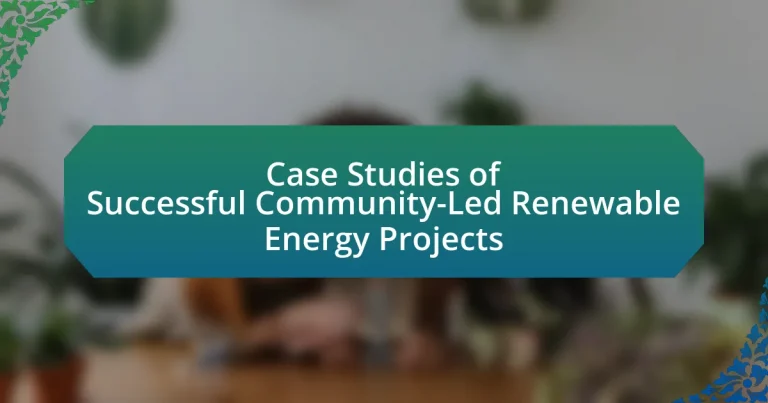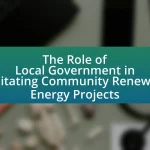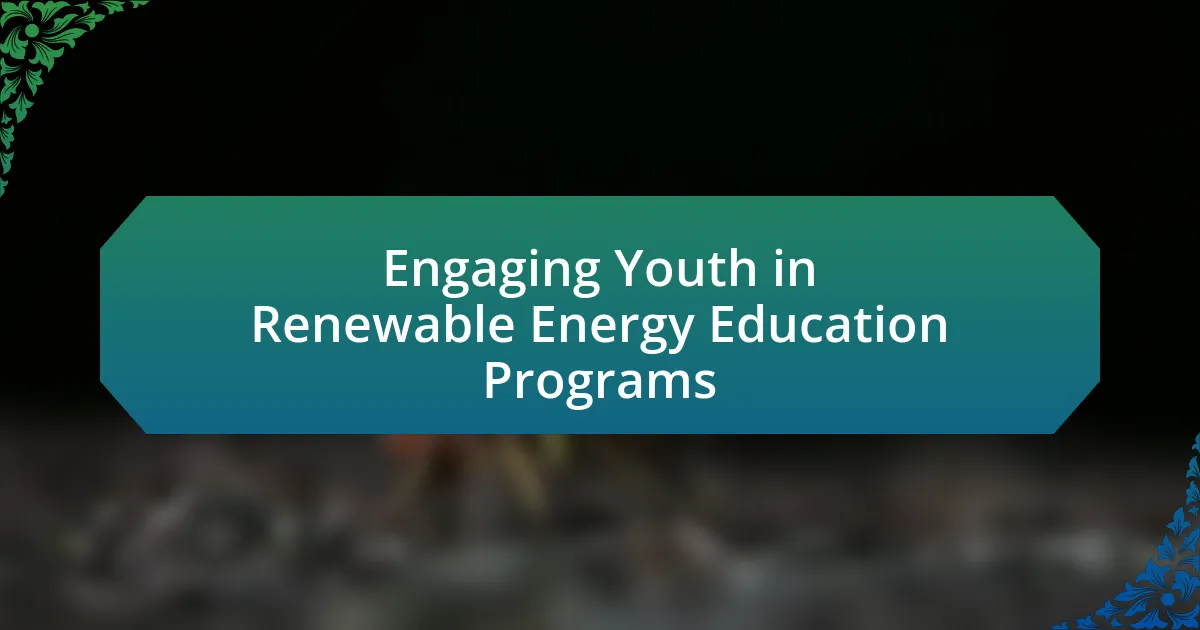Community-led renewable energy projects are initiatives where local communities take charge of developing, managing, and benefiting from renewable energy sources such as solar and wind. These projects differ from traditional energy initiatives by emphasizing local governance and stakeholder participation, which enhances community ownership and accountability. The article explores the roles of community members, the types of renewable energy commonly used, and the economic and environmental benefits these projects provide. It also addresses the challenges faced, including funding and regulatory hurdles, while highlighting successful case studies that demonstrate effective community engagement and collaboration. Key strategies for initiating and sustaining these projects are discussed, along with available resources and funding opportunities to support community-led initiatives.
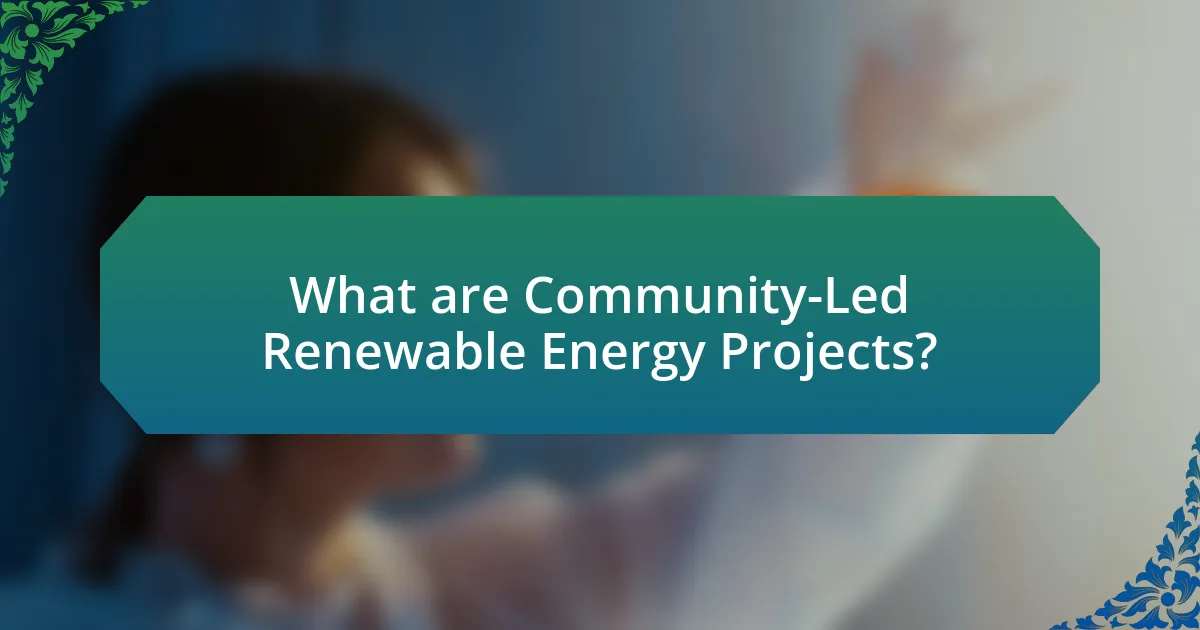
What are Community-Led Renewable Energy Projects?
Community-led renewable energy projects are initiatives where local communities take the lead in developing, managing, and benefiting from renewable energy sources. These projects often involve the installation of solar panels, wind turbines, or other renewable technologies, with community members actively participating in decision-making processes and ownership structures. Evidence shows that such projects can enhance local energy security, reduce greenhouse gas emissions, and foster economic development by keeping energy revenues within the community. For instance, a study by the International Renewable Energy Agency highlights that community-led projects can lead to a 20% increase in local job creation compared to traditional energy projects.
How do community-led renewable energy projects differ from traditional energy projects?
Community-led renewable energy projects differ from traditional energy projects primarily in their governance and ownership structures. In community-led projects, local stakeholders actively participate in decision-making and benefit-sharing, fostering a sense of ownership and accountability. For instance, a study by the International Renewable Energy Agency (IRENA) highlights that community energy initiatives often prioritize local needs and preferences, leading to tailored solutions that enhance social acceptance and environmental sustainability. In contrast, traditional energy projects are typically managed by large corporations or government entities, focusing on profit maximization and centralized control, which can result in disconnect from local communities and their specific energy requirements.
What roles do community members play in these projects?
Community members play crucial roles in community-led renewable energy projects by participating in decision-making, funding, and implementation processes. They often contribute their local knowledge and expertise, which helps tailor projects to meet specific community needs and preferences. For instance, in the Gleaners Community Solar Project in Massachusetts, residents were actively involved in planning and financing, leading to a project that reflects their energy goals and values. This engagement not only fosters a sense of ownership but also enhances project sustainability and success.
What types of renewable energy sources are commonly used?
Commonly used renewable energy sources include solar, wind, hydroelectric, geothermal, and biomass energy. Solar energy harnesses sunlight through photovoltaic cells or solar thermal systems, while wind energy captures kinetic energy from wind using turbines. Hydroelectric energy generates power from flowing water, typically through dams. Geothermal energy utilizes heat from the Earth’s interior, and biomass energy derives from organic materials. According to the International Renewable Energy Agency (IRENA), as of 2021, solar and wind energy have seen the most significant growth, contributing to over 90% of new renewable capacity additions globally.
Why are community-led renewable energy projects important?
Community-led renewable energy projects are important because they empower local communities to take control of their energy production and consumption, fostering sustainability and resilience. These projects often lead to increased energy independence, reduced greenhouse gas emissions, and economic benefits through job creation and local investment. For instance, a study by the International Renewable Energy Agency (IRENA) found that community energy initiatives can reduce energy costs by up to 30% compared to traditional energy sources, demonstrating their financial viability and impact. Additionally, these projects enhance social cohesion by involving community members in decision-making processes, thereby strengthening community ties and promoting collective action towards environmental goals.
How do they contribute to local economies?
Community-led renewable energy projects contribute to local economies by creating jobs, reducing energy costs, and fostering local investment. These projects often require local labor for installation and maintenance, which generates employment opportunities and stimulates economic activity. For instance, a study by the National Renewable Energy Laboratory found that community solar projects can create approximately 1.5 jobs per installed kilowatt, leading to significant local job creation. Additionally, by producing energy locally, these projects can lower energy bills for residents and businesses, allowing them to allocate funds to other local expenditures. Furthermore, community-led initiatives often attract investment from local stakeholders, enhancing the economic resilience of the community.
What environmental benefits do they provide?
Community-led renewable energy projects provide significant environmental benefits, primarily by reducing greenhouse gas emissions. These projects often utilize solar, wind, or biomass energy, which produce little to no emissions compared to fossil fuels. For instance, a study by the International Renewable Energy Agency (IRENA) found that renewable energy sources can reduce carbon dioxide emissions by up to 70% in the energy sector. Additionally, these projects promote biodiversity by minimizing habitat destruction associated with traditional energy extraction methods. By fostering local energy production, they also decrease reliance on imported fuels, which can lead to lower environmental degradation from transportation.
What challenges do community-led renewable energy projects face?
Community-led renewable energy projects face several challenges, including funding difficulties, regulatory barriers, and community engagement issues. Funding is often limited, as these projects typically rely on grants, donations, or community investments, which can be inconsistent. Regulatory barriers can arise from complex permitting processes and local government policies that may not favor renewable initiatives. Additionally, engaging the community is crucial; without sufficient local support and participation, projects may struggle to gain traction or sustain momentum. These challenges are documented in various studies, such as the report by the International Renewable Energy Agency, which highlights the importance of addressing financial and regulatory obstacles to enhance the viability of community-led initiatives.
How do funding and financial sustainability impact these projects?
Funding and financial sustainability are critical to the success of community-led renewable energy projects as they determine the resources available for development, implementation, and maintenance. Adequate funding ensures that projects can cover initial capital costs, such as equipment and installation, while financial sustainability allows for ongoing operational expenses and long-term viability. For instance, a study by the International Renewable Energy Agency (IRENA) highlights that projects with diverse funding sources, including grants, loans, and community investments, are more likely to succeed and sustain operations over time. This diversity mitigates risks associated with reliance on a single funding stream and enhances resilience against economic fluctuations.
What regulatory hurdles must communities overcome?
Communities must overcome zoning regulations, permitting processes, and interconnection standards to successfully implement renewable energy projects. Zoning regulations can restrict the types of energy installations allowed in certain areas, while permitting processes often involve lengthy applications and compliance with local, state, and federal laws. Additionally, interconnection standards dictate how renewable energy systems connect to the existing grid, which can pose technical and bureaucratic challenges. For instance, a study by the National Renewable Energy Laboratory highlights that streamlined permitting can significantly reduce project timelines and costs, demonstrating the importance of addressing these regulatory hurdles for successful community-led initiatives.
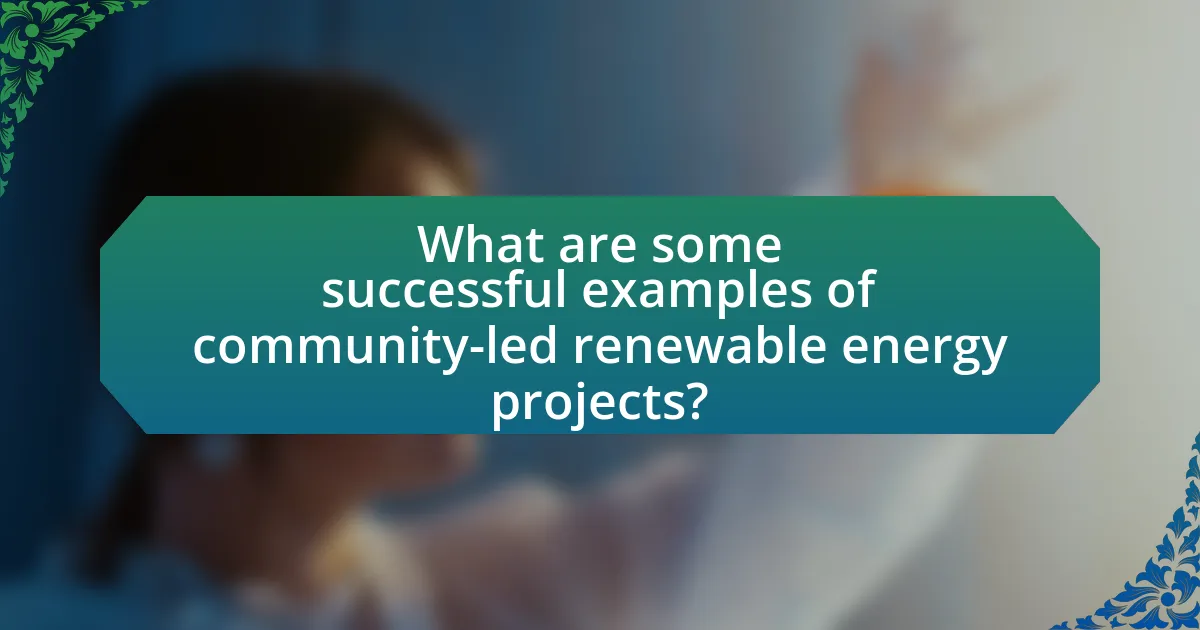
What are some successful examples of community-led renewable energy projects?
Some successful examples of community-led renewable energy projects include the Gleaners Community Food Bank in Michigan, which installed solar panels to reduce energy costs and promote sustainability, and the Samso Island project in Denmark, where the community transitioned to 100% renewable energy through wind and solar initiatives. These projects demonstrate the effectiveness of local engagement in renewable energy solutions, with Samso Island achieving energy independence and Gleaners significantly lowering operational expenses while enhancing their environmental impact.
How did these projects achieve success?
These projects achieved success through strong community engagement and collaboration, which fostered local ownership and commitment. For instance, community-led initiatives often involved residents in decision-making processes, ensuring that the projects met local needs and garnered widespread support. Additionally, securing funding from diverse sources, such as government grants and private investments, provided the necessary financial backing to implement renewable energy solutions. Evidence of success can be seen in projects like the Samso Island project in Denmark, which transitioned to 100% renewable energy through community involvement and innovative financing, demonstrating that local participation and strategic funding are critical factors in achieving sustainable energy goals.
What strategies were employed to engage the community?
Community engagement strategies included participatory workshops, surveys, and local partnerships. Participatory workshops allowed community members to voice their opinions and contribute ideas, fostering a sense of ownership in renewable energy projects. Surveys collected feedback on community needs and preferences, ensuring that projects aligned with local interests. Additionally, forming partnerships with local organizations and stakeholders facilitated trust and collaboration, enhancing community involvement and support for renewable energy initiatives. These strategies have been shown to increase project success rates and community satisfaction, as evidenced by various case studies in successful community-led renewable energy projects.
What partnerships were formed to support these initiatives?
Partnerships formed to support community-led renewable energy initiatives include collaborations between local governments, non-profit organizations, and private sector companies. For example, the Solarize program in various U.S. cities has partnered with local municipalities and solar installation companies to provide affordable solar energy solutions. Additionally, community cooperatives often collaborate with universities for research and development, enhancing project viability and sustainability. These partnerships leverage resources, expertise, and funding, demonstrating their effectiveness in advancing renewable energy projects within communities.
What lessons can be learned from these case studies?
The lessons learned from case studies of successful community-led renewable energy projects include the importance of local engagement, the effectiveness of collaborative governance, and the necessity of tailored financing models. Local engagement fosters a sense of ownership and commitment among community members, which has been shown to increase project sustainability and success rates. Collaborative governance structures, where stakeholders work together, enhance decision-making and resource allocation, as evidenced by projects that have successfully navigated regulatory challenges through community coalitions. Tailored financing models, such as community investment funds, have proven effective in mobilizing local resources and ensuring financial viability, as seen in various successful initiatives that have reduced reliance on external funding sources.
What common factors contributed to their success?
Common factors that contributed to the success of community-led renewable energy projects include strong local engagement, effective collaboration among stakeholders, and access to funding. Strong local engagement ensures that community members are invested in the project, leading to higher participation rates and support. Effective collaboration among stakeholders, including local governments, non-profits, and private sector partners, facilitates resource sharing and expertise, enhancing project viability. Access to funding, often through grants or community financing models, provides the necessary financial resources to initiate and sustain these projects. These elements have been consistently observed in successful case studies, demonstrating their critical role in achieving project goals.
How can these lessons be applied to future projects?
Lessons from successful community-led renewable energy projects can be applied to future projects by emphasizing community engagement, stakeholder collaboration, and adaptive management. Community engagement ensures that local needs and preferences are prioritized, which increases project acceptance and sustainability. For instance, the success of the Samso Island project in Denmark, where local residents actively participated in decision-making, demonstrates that involving the community leads to higher commitment and investment in renewable initiatives. Stakeholder collaboration fosters partnerships among local governments, businesses, and residents, enhancing resource sharing and expertise, as seen in the Solarize program in Massachusetts, which effectively mobilized community resources for solar energy adoption. Adaptive management allows projects to evolve based on feedback and changing conditions, ensuring long-term viability, as evidenced by the ongoing adjustments made in the community wind projects in Germany to optimize performance and address challenges.
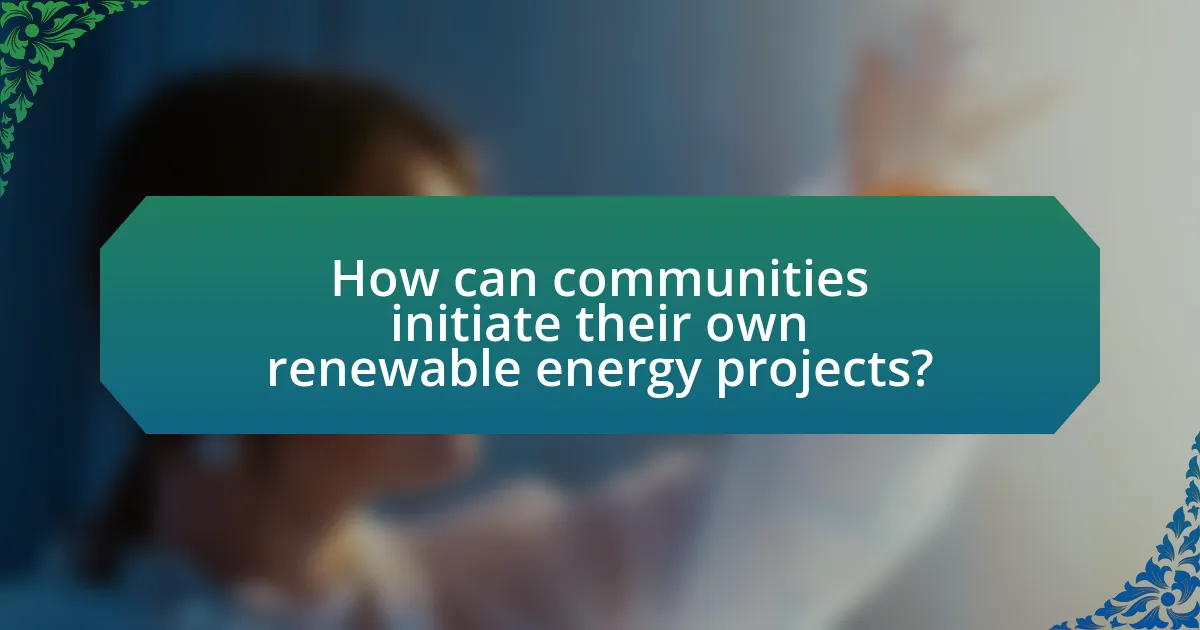
How can communities initiate their own renewable energy projects?
Communities can initiate their own renewable energy projects by forming a local energy cooperative or organization that brings together residents to collaboratively plan and implement renewable energy solutions. This approach allows communities to pool resources, share knowledge, and leverage collective purchasing power for technologies such as solar panels or wind turbines. For instance, the community of Lancaster, California, established a solar energy program that resulted in over 100 megawatts of solar capacity, demonstrating the effectiveness of community-led initiatives. Additionally, securing funding through grants, government incentives, or crowdfunding can further support these projects, as seen in the case of the Solarize program, which has successfully helped numerous communities across the United States to adopt solar energy.
What steps should communities take to start a renewable energy project?
Communities should begin a renewable energy project by conducting a feasibility study to assess local resources and energy needs. This initial step involves gathering data on available renewable resources, such as solar, wind, or biomass, and evaluating the community’s energy consumption patterns. Following the feasibility study, communities should engage stakeholders, including local government, residents, and potential investors, to build support and gather input.
Next, communities must develop a detailed project plan that outlines objectives, timelines, and budget estimates. Securing funding through grants, loans, or community fundraising is crucial for project viability. After funding is in place, communities should navigate regulatory requirements, including permits and environmental assessments, to ensure compliance with local laws.
Finally, communities can implement the project by selecting appropriate technologies, hiring contractors, and overseeing construction. Successful examples, such as the Solarize program in Portland, Oregon, demonstrate that these steps lead to effective community-led renewable energy initiatives.
How can communities assess their energy needs and resources?
Communities can assess their energy needs and resources by conducting comprehensive energy audits and engaging in stakeholder consultations. Energy audits involve analyzing current energy consumption patterns, identifying peak usage times, and evaluating existing energy infrastructure. Stakeholder consultations, which include input from residents, local businesses, and energy providers, help to gather diverse perspectives on energy requirements and potential resources.
For instance, a study by the U.S. Department of Energy highlights that communities that perform detailed energy assessments can identify specific areas for improvement, leading to more efficient energy use and the integration of renewable energy sources. Additionally, tools like the Energy Star Portfolio Manager can assist communities in tracking energy performance and benchmarking against similar entities, providing concrete data to inform decisions.
What are the best practices for community engagement and participation?
The best practices for community engagement and participation include fostering open communication, building trust, and ensuring inclusivity. Open communication allows community members to express their ideas and concerns, which is essential for effective collaboration. Building trust involves transparency in decision-making processes and demonstrating commitment to community interests, which can enhance participation rates. Ensuring inclusivity means actively involving diverse groups within the community, including marginalized voices, to create a sense of ownership and shared responsibility. Research shows that projects with high levels of community engagement, such as the community-led renewable energy initiatives in Denmark, have resulted in increased project success and sustainability, highlighting the importance of these practices.
What resources are available to support community-led renewable energy initiatives?
Community-led renewable energy initiatives can access various resources, including funding opportunities, technical assistance, and educational programs. For instance, organizations like the U.S. Department of Energy provide grants and financial incentives specifically aimed at supporting community energy projects. Additionally, platforms such as the National Renewable Energy Laboratory offer technical resources and guidance to help communities design and implement renewable energy systems. Furthermore, local and state governments often have programs that facilitate community engagement and provide training on renewable energy technologies, enhancing the capacity of communities to lead their own initiatives.
What funding opportunities exist for these projects?
Funding opportunities for community-led renewable energy projects include government grants, private investments, and crowdfunding initiatives. For instance, the U.S. Department of Energy offers various grant programs specifically aimed at supporting renewable energy projects, such as the Solar Energy Technologies Office funding opportunities. Additionally, organizations like the Renewable Energy and Energy Efficiency Partnership provide financial support for community-based initiatives. Crowdfunding platforms, such as Kickstarter and Indiegogo, also allow communities to raise funds directly from individuals interested in supporting renewable energy efforts. These funding sources are essential for the development and sustainability of community-led renewable energy projects.
How can communities access technical assistance and expertise?
Communities can access technical assistance and expertise through partnerships with local universities, non-profit organizations, and government agencies that specialize in renewable energy. These entities often provide resources such as training programs, workshops, and consulting services tailored to community needs. For example, the U.S. Department of Energy offers various technical assistance programs aimed at supporting community-led renewable energy initiatives, which include access to expert advice and funding opportunities. Additionally, organizations like the National Renewable Energy Laboratory provide research and data that can help communities make informed decisions about renewable energy projects.
What are the best practices for sustaining community-led renewable energy projects?
The best practices for sustaining community-led renewable energy projects include fostering strong community engagement, ensuring financial viability, and establishing effective governance structures. Strong community engagement involves actively involving local residents in decision-making processes, which enhances ownership and commitment to the project. Financial viability can be achieved through diverse funding sources, such as grants, crowdfunding, and partnerships with local businesses, ensuring that the project can sustain itself over time. Effective governance structures, including transparent management and clear roles for stakeholders, help maintain accountability and facilitate smooth operations. These practices are supported by successful examples, such as the community solar projects in Germany, which have thrived due to robust local participation and financial models that empower residents.
How can communities ensure ongoing participation and support?
Communities can ensure ongoing participation and support by fostering inclusive decision-making processes that engage all stakeholders. This approach encourages diverse input and strengthens community ownership of projects, leading to sustained interest and commitment. For instance, the success of the Güssing Renewable Energy Community in Austria demonstrates that involving residents in planning and implementation can lead to a 100% renewable energy supply, as community members feel a sense of responsibility and pride in the outcomes. Additionally, regular communication and transparent reporting on project progress can maintain enthusiasm and trust, further solidifying community support.
What strategies can be implemented for long-term financial viability?
To ensure long-term financial viability in community-led renewable energy projects, implementing diversified funding sources is essential. This strategy includes securing grants, attracting private investments, and establishing community financing models, which collectively enhance financial stability. For instance, the Solar Community Initiative in California successfully utilized a combination of state grants and local crowdfunding, resulting in a 30% increase in project funding compared to traditional methods. Additionally, creating partnerships with local businesses can provide ongoing revenue streams and support, as demonstrated by the Wind Cooperative in Minnesota, which generated 25% of its operational budget through local business collaborations. These strategies not only mitigate financial risks but also foster community engagement and ownership, crucial for the sustainability of renewable energy initiatives.
